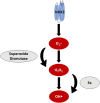Therapeutic targeting of microglia mediated oxidative stress after neurotrauma
- PMID: 36405593
- PMCID: PMC9671221
- DOI: 10.3389/fmed.2022.1034692
Therapeutic targeting of microglia mediated oxidative stress after neurotrauma
Abstract
Inflammation is a primary component of the central nervous system injury response. Traumatic brain and spinal cord injury are characterized by a pronounced microglial response to damage, including alterations in microglial morphology and increased production of reactive oxygen species (ROS). The acute activity of microglia may be beneficial to recovery, but continued inflammation and ROS production is deleterious to the health and function of other cells. Microglial nicotinamide adenine dinucleotide phosphate (NADPH) oxidase (NOX), mitochondria, and changes in iron levels are three of the most common sources of ROS. All three play a significant role in post-traumatic brain and spinal cord injury ROS production and the resultant oxidative stress. This review will evaluate the current state of therapeutics used to target these avenues of microglia-mediated oxidative stress after injury and suggest avenues for future research.
Keywords: NADPH oxidase; iron; microglia; mitochondria; oxidative stress; spinal cord injury; traumatic brain injury.
Copyright © 2022 Smith, Shaughness, Collier, Hopkins and Byrnes.
Conflict of interest statement
The authors declare that the research was conducted in the absence of any commercial or financial relationships that could be construed as a potential conflict of interest.
Figures



Similar articles
-
Central Nervous System Injury and Nicotinamide Adenine Dinucleotide Phosphate Oxidase: Oxidative Stress and Therapeutic Targets.J Neurotrauma. 2017 Feb 15;34(4):755-764. doi: 10.1089/neu.2016.4486. Epub 2016 Jun 27. J Neurotrauma. 2017. PMID: 27267366 Free PMC article. Review.
-
NADPH oxidase isoform expression is temporally regulated and may contribute to microglial/macrophage polarization after spinal cord injury.Mol Cell Neurosci. 2016 Dec;77:53-64. doi: 10.1016/j.mcn.2016.10.001. Epub 2016 Oct 10. Mol Cell Neurosci. 2016. PMID: 27729244 Free PMC article.
-
Iron accentuated reactive oxygen species release by NADPH oxidase in activated microglia contributes to oxidative stress in vitro.J Neuroinflammation. 2019 Feb 18;16(1):41. doi: 10.1186/s12974-019-1430-7. J Neuroinflammation. 2019. PMID: 30777083 Free PMC article.
-
Age increases reactive oxygen species production in macrophages and potentiates oxidative damage after spinal cord injury.Neurobiol Aging. 2016 Nov;47:157-167. doi: 10.1016/j.neurobiolaging.2016.07.029. Epub 2016 Aug 6. Neurobiol Aging. 2016. PMID: 27596335 Free PMC article.
-
MicroRNA Targeting Nicotinamide Adenine Dinucleotide Phosphate Oxidases in Cancer.Antioxid Redox Signal. 2020 Feb 10;32(5):267-284. doi: 10.1089/ars.2019.7918. Epub 2019 Nov 21. Antioxid Redox Signal. 2020. PMID: 31656079 Review.
Cited by
-
Traumatic brain injury-associated epigenetic changes and the risk for neurodegenerative diseases.Front Neurosci. 2023 Sep 19;17:1259405. doi: 10.3389/fnins.2023.1259405. eCollection 2023. Front Neurosci. 2023. PMID: 37795186 Free PMC article.
-
Oxidative stress and inflammation cause auditory system damage via glial cell activation and dysregulated expression of gap junction proteins in an experimental model of styrene-induced oto/neurotoxicity.J Neuroinflammation. 2024 Jan 4;21(1):4. doi: 10.1186/s12974-023-02996-3. J Neuroinflammation. 2024. PMID: 38178142 Free PMC article.
-
Spinal Cord Injury Management Based on Microglia-Targeting Therapies.J Clin Med. 2024 May 8;13(10):2773. doi: 10.3390/jcm13102773. J Clin Med. 2024. PMID: 38792314 Free PMC article. Review.
-
Multi-target approach to Alzheimer's disease prevention and treatment: antioxidant, anti-inflammatory, and amyloid- modulating mechanisms.Neurogenetics. 2025 Apr 1;26(1):39. doi: 10.1007/s10048-025-00821-y. Neurogenetics. 2025. PMID: 40167826 Review.
-
Targeting Spermine Oxidase to Mitigate Traumatic Brain Injury Pathology in the Aging Brain.Antioxidants (Basel). 2025 Jun 11;14(6):709. doi: 10.3390/antiox14060709. Antioxidants (Basel). 2025. PMID: 40563341 Free PMC article.
References
-
- Nscisc. National spinal cord injury statistical center, facts and figures at a glance. Birmingham, Al: University of Alabama at Birmingham; (2016).
Publication types
LinkOut - more resources
Full Text Sources

